Interfacing 2D Semiconductors with Functional Oxides: Fundamentals, Properties, and Applications
Abstract
:1. Introduction
2. Physical Effects of Oxides on 2D Semiconductors
2.1. 2D Semiconductors/Traditional Dielectric Material Heterostructures
2.2. 2D Semiconductors/Semiconducting Oxide Heterostructures
2.3. 2D Semiconductors/Conventional Piezoelectric Oxide Heterostructures
2.4. 2D Semiconductors/Strongly Correlated Oxide Heterostructures
2.5. 2D Semiconductors/Magnetic Oxide Heterostructures
3. Applications of 2D Semiconductors/Functional Oxide Heterostructures
3.1. Volatile Field-Effect Transistor (FET) Devices
3.2. Nonvolatile Memory and Data Storage
3.3. Sensing and Detection
4. Perspectives and Challenges
Acknowledgments
Author Contributions
Conflicts of Interest
References
- Liu, K.; Yan, Q.; Chen, M.; Fan, W.; Sun, Y.; Suh, J.; Fu, D.; Lee, S.; Zhou, J.; Tongay, S. Elastic properties of chemical-vapor-deposited monolayer MoS2, WS2, and their bilayer heterostructures. Nano Lett. 2014, 14, 5097–5103. [Google Scholar] [CrossRef] [PubMed]
- Lee, C.; Wei, X.; Kysar, J.W.; Hone, J. Measurement of the elastic properties and intrinsic strength of monolayer graphene. Science 2008, 321, 385–388. [Google Scholar] [CrossRef] [PubMed]
- Balandin, A.A.; Ghosh, S.; Bao, W.; Calizo, I.; Teweldebrhan, D.; Miao, F.; Lau, C.N. Superior thermal conductivity of single-layer graphene. Nano Lett. 2008, 8, 902–907. [Google Scholar] [CrossRef] [PubMed]
- Tongay, S.; Fan, W.; Kang, J.; Park, J.; Koldemir, U.; Suh, J.; Narang, D.S.; Liu, K.; Ji, J.; Li, J. Tuning interlayer coupling in large-area heterostructures with cvd-grown MoS2 and WS2 monolayers. Nano Lett. 2014, 14, 3185–3190. [Google Scholar] [CrossRef] [PubMed]
- Sun, Y.; Liu, K.; Hong, X.; Chen, M.; Kim, J.; Shi, S.; Wu, J.; Zettl, A.; Wang, F. Probing local strain at MX2-metal boundaries with surface plasmon-enhanced raman scattering. Nano Lett. 2014, 14, 5329–5334. [Google Scholar] [CrossRef] [PubMed]
- Wilk, G.D.; Wallace, R.M.; Anthony, J. High-κ gate dielectrics: Current status and materials properties considerations. J. Appl. Phys. 2001, 89, 5243–5275. [Google Scholar] [CrossRef]
- Osada, M.; Sasaki, T. Two-dimensional dielectric nanosheets: Novel nanoelectronics from nanocrystal building blocks. Adv. Mater. 2012, 24, 210–228. [Google Scholar] [CrossRef] [PubMed]
- Lee, Y.S.; Shim, T.H.; Yoo, S.D.; Park, J.G. Silicon thickness fluctuation scattering dependence of electron mobility in ultrathin body silicon-on-insulator n-metal-oxide-semiconductor field-effect transistors. J. Appl. Phys. 2008, 103, 084503. [Google Scholar] [CrossRef]
- Radisavljevic, B.; Radenovic, A.; Brivio, J.; Giacometti, I.V.; Kis, A. Single-layer MoS2 transistors. Nat. Nanotechnol. 2011, 6, 147–150. [Google Scholar] [CrossRef] [PubMed]
- Ghatak, S.; Pal, A.N.; Ghosh, A. Nature of electronic states in atomically thin MoS2 field-effect transistors. ACS Nano 2011, 5, 7707–7712. [Google Scholar] [CrossRef] [PubMed]
- Fivaz, R.; Mooser, E. Mobility of charge carriers in semiconducting layer structures. Phys. Rev. 1967, 163, 743. [Google Scholar] [CrossRef]
- Radisavljevic, B.; Kis, A. Mobility engineering and a metal-insulator transition in monolayer MoS2. Nat. Mater. 2013, 12, 815–820. [Google Scholar] [CrossRef] [PubMed]
- Li, S.-L.; Wakabayashi, K.; Xu, Y.; Nakaharai, S.; Komatsu, K.; Li, W.W.; Lin, Y.F.; Aparecido-Ferreira, A.; Tsukagoshi, K. Thickness-dependent interfacial coulomb scattering in atomically thin field-effect transistors. Nano Lett. 2013, 13, 3546–3552. [Google Scholar] [CrossRef] [PubMed]
- Kim, J.K.; Cho, K.; Kim, T.Y.; Pak, J.; Jang, J.; Song, Y.; Kim, Y.; Choi, B.Y.; Chung, S.; Hong, W.K. Trap-mediated electronic transport properties of gate-tunable pentacene/MoS2 pn heterojunction diodes. Sci. Rep. 2016, 6, 36775. [Google Scholar] [CrossRef] [PubMed]
- Ayari, A.; Cobas, E.; Ogundadegbe, O.; Fuhrer, M.S. Realization and electrical characterization of ultrathin crystals of layered transition-metal dichalcogenides. J. Appl. Phys. 2007, 101, 14507. [Google Scholar] [CrossRef]
- Dolui, K.; Rungger, I.; Sanvito, S. Origin of the n-type and p-type conductivity of MoS2 monolayers on a SiO2 substrate. Phys. Rev. B 2013, 87, 165402. [Google Scholar] [CrossRef]
- Hess, K.; Vogl, P. Remote polar phonon scattering in silicon inversion layers. Solid State Commun. 1979, 30, 797–799. [Google Scholar] [CrossRef]
- Kaasbjerg, K.; Thygesen, K.S.; Jauho, A.P. Acoustic phonon limited mobility in two-dimensional semiconductors: Deformation potential and piezoelectric scattering in monolayer MoS2 from first principles. Phys. Rev. B 2013, 87, 235312. [Google Scholar] [CrossRef]
- Ma, N.; Jena, D. Charge scattering and mobility in atomically thin semiconductors. Phys. Rev. X 2014, 4, 011043. [Google Scholar] [CrossRef]
- Lin, Y.; Ling, X.; Yu, L.; Huang, S.; Hsu, A.L.; Lee, Y.-H.; Kong, J.; Dresselhaus, M.S.; Palacios, T.S. Dielectric screening of excitons and trions in single-layer MoS2. Nano Lett. 2014, 14, 5569–5576. [Google Scholar] [CrossRef] [PubMed]
- Li, Y.; Qi, Z.; Liu, M.; Wang, Y.; Cheng, X.; Zhang, G.; Sheng, L. Photoluminescence of monolayer MoS2 on LaAlO3 and SrTiO3 substrates. Nanoscale 2014, 6, 15248–15254. [Google Scholar] [CrossRef] [PubMed]
- Sun, Y.; Wang, R.; Liu, K. Substrate induced changes in atomically thin 2-dimensional semiconductors: Fundamentals, engineering, and applications. Appl. Phys. Rev. 2017, 4, 011301. [Google Scholar] [CrossRef]
- Ross, J.S.; Wu, S.; Yu, H.; Ghimire, N.J.; Jones, A.M.; Aivazian, G.; Yan, J.; Mandrus, D.G.; Xiao, D.; Yao, W.; et al. Electrical control of neutral and charged excitons in a monolayer semiconductor. Nat. Commun. 2013, 4. [Google Scholar] [CrossRef] [PubMed] [Green Version]
- Mak, K.F.; He, K.; Lee, C.; Lee, G.H.; Hone, J.; Heinz, T.F.; Shan, J. Tightly bound trions in monolayer MoS2. Nat. Mater. 2013, 12, 207–211. [Google Scholar] [CrossRef] [PubMed]
- Buscema, M.; Steele, G.A.; van der Zant, H.S.; Castellanos-Gomez, A. The effect of the substrate on the raman and photoluminescence emission of single-layer MoS2. Nano Res. 2014, 7, 561–571. [Google Scholar] [CrossRef]
- Pradhan, S.K.; Xiao, B.; Pradhan, A.K. Energy band alignment of high-k oxide heterostructures at MoS2/Al2O3 and MoS2/ZrO2 interfaces. J. Appl. Phys. 2016, 120, 125305. [Google Scholar] [CrossRef]
- Zhou, P.; Xu, Q.; Li, H.; Wang, Y.; Yan, B.; Zhou, Y.; Chen, J.; Zhang, J.; Wang, K. Fabrication of two-dimensional lateral heterostructures of WS2/WO3 H2O through selective oxidation of monolayer WS2. Angew. Chem. Int. Ed. 2015, 54, 15226–15230. [Google Scholar] [CrossRef] [PubMed]
- Shim, G.W.; Yoo, K.; Seo, S.-B.; Shin, J.; Jung, D.Y.; Kang, I.-S.; Ahn, C.W.; Cho, B.J.; Choi, S.-Y. Large-area single-layer MoSe2 and its van der waals heterostructures. ACS Nano 2014, 8, 6655–6662. [Google Scholar] [CrossRef] [PubMed]
- Novoselov, K.; Mishchenko, A.; Carvalho, A.; Neto, A.C. 2D materials and van der waals heterostructures. Science 2016, 353, aac9439. [Google Scholar] [CrossRef] [PubMed]
- Wang, H.; Zhang, C.; Rana, F. Ultrafast dynamics of defect-assisted electron–hole recombination in monolayer MoS2. Nano Lett. 2014, 15, 339–345. [Google Scholar] [CrossRef] [PubMed]
- Liu, H.; Neal, A.T.; Si, M.; Du, Y.; Peide, D.Y. The effect of dielectric capping on few-layer phosphorene transistors: Tuning the schottky barrier heights. IEEE Electron Device Lett. 2014, 35, 795–797. [Google Scholar]
- Anderson, R. Germanium-gallium arsenide heterojunctions. IBM J. Res. Dev. 1960, 4, 283–287. [Google Scholar]
- Tersoff, J. Theory of semiconductor heterojunctions: The role of quantum dipoles. Phys. Rev. B 1984, 30, 4874. [Google Scholar] [CrossRef]
- Livingston, J.D. Electronic Properties of Engineering Materials; Wiley: New York, NY, USA, 1999. [Google Scholar]
- Ozcelik, V.O.; Azadani, J.G.; Yang, C.; Koester, S.J.; Low, T. Band alignment of two-dimensional semiconductors for designing heterostructures with momentum space matching. Phys. Rev. B 2016, 94. [Google Scholar] [CrossRef]
- Arakawa, Y.; Yariv, A. Quantum well lasers—Gain, spectra, dynamics. IEEE J. Quantum Electron. 1986, 22, 1887–1899. [Google Scholar] [CrossRef]
- Nakamura, S.; Senoh, M.; Iwasa, N.; Nagahama, S.-I. High-brightness ingan blue, green and yellow light-emitting diodes with quantum well structures. Jpn. J. Appl. Phys. 1995, 34, L797. [Google Scholar] [CrossRef]
- Werking, J.D.; Bolognesi, C.R.; Chang, L.-D.; Nguyen, C.; Hu, E.L.; Kroemer, H. High-transconductance InAs/AlSb heterojunction field-effect transistors with delta-doped alsb upper barriers. IEEE Electron Device Lett. 1992, 13, 164–166. [Google Scholar] [CrossRef]
- Zhang, Y.; Ma, W.; Cao, Y.; Huang, J.; Wei, Y.; Cui, K.; Shao, J. Long wavelength infrared InAs/GaSb superlattice photodetectors with InSb-like and mixed interfaces. IEEE J. Quantum Electron. 2011, 47, 1475–1479. [Google Scholar] [CrossRef]
- Howell, S.L.; Jariwala, D.; Wu, C.C.; Chen, K.S.; Sangwan, V.K.; Kang, J.; Marks, T.J.; Hersam, M.C.; Lauhon, L.J. Investigation of band-offsets at monolayer–multilayer MoS2 junctions by scanning photocurrent microscopy. Nano Lett. 2015, 15, 2278–2284. [Google Scholar] [CrossRef] [PubMed]
- Meyer, J.; Hoffman, C.; Bartoli, F.; Ram-Mohan, L. Type-II quantum-well lasers for the mid-wavelength infrared. Appl. Phys. Lett. 1995, 67, 757–759. [Google Scholar] [CrossRef]
- Koswatta, S.O.; Koester, S.J.; Haensch, W. On the possibility of obtaining MOSFET-like performance and sub-60-mV/dec swing in 1-D broken-gap tunnel transistors. IEEE Trans. Electron Devices 2010, 57, 3222–3230. [Google Scholar] [CrossRef]
- Hwang, J.S.; Lin, K.I.; Lin, H.; Hsu, S.; Chen, K.; Lu, Y.T.; Hong, Y.; Tu, C. Studies of band alignment and two-dimensional electron gas in in Ga PN/Ga AS heterostructures. Appl. Phys. Lett. 2005, 86, 061103. [Google Scholar] [CrossRef]
- Liu, X.; Petrou, A.; Warnock, J.; Jonker, B.; Prinz, G.; Krebs, J. Spin-dependent type-I, type-II behavior in a quantum well system. Phys. Rev. Lett. 1989, 63, 2280. [Google Scholar] [CrossRef] [PubMed]
- Rivera, P.; Schaibley, J.R.; Jones, A.M.; Ross, J.S.; Wu, S.; Aivazian, G.; Klement, P.; Seyler, K.; Clark, G.; Ghimire, N.J. Observation of long-lived interlayer excitons in monolayer MoSe2–WSe2 heterostructures. Nat. Commun. 2015, 6, 4985. [Google Scholar] [CrossRef] [PubMed] [Green Version]
- Chiu, M.H.; Zhang, C.; Shiu, H.W.; Chuu, C.P.; Chen, C.H.; Chang, C.Y.S.; Chen, C.H.; Chou, M.Y.; Shih, C.K.; Li, L.J. Determination of band alignment in the single-layer MoS2/WSe2 heterojunction. Nat. Commun. 2015, 6. [Google Scholar] [CrossRef] [PubMed]
- Poweleit, C.; Smith, L.; Jonker, B. Observation of long-lived exciton magnetic polarons in Zn1−xMnx Se/ZnSe multiple quantum wells. Phys. Rev. B 1994, 50, 18662. [Google Scholar] [CrossRef]
- Rossin, V.; Böttger, T.; Henneberger, F. Type-II interface exciton in ZnSe/(Zn, Mn) se heterostructures. Phys. Rev. B 1996, 54, 7682. [Google Scholar] [CrossRef]
- Chuang, S.; Battaglia, C.; Azcatl, A.; McDonnell, S.; Kang, J.S.; Yin, X.; Tosun, M.; Kapadia, R.; Fang, H.; Wallace, R.M. MoS2 p-type transistors and diodes enabled by high work function moo x contacts. Nano Lett. 2014, 14, 1337–1342. [Google Scholar] [CrossRef] [PubMed]
- Lin, J.; Zhong, J.; Zhong, S.; Li, H.; Zhang, H.; Chen, W. Modulating electronic transport properties of MoS2 field effect transistor by surface overlayers. Appl. Phys. Lett. 2013, 103, 063109. [Google Scholar] [CrossRef]
- Chen, L.; Xue, F.; Li, X.; Huang, X.; Wang, L.; Kou, J.; Wang, Z.L. Strain-gated field effect transistor of a MoS2–ZnO 2D–1D hybrid structure. ACS Nano 2015, 10, 1546–1551. [Google Scholar] [CrossRef] [PubMed]
- Park, W.; Yang, J.H.; Kang, C.G.; Lee, Y.G.; Hwang, H.J.; Cho, C.; Lim, S.K.; Kang, S.C.; Hong, W.K.; Lee, S.K. Characteristics of a pressure sensitive touch sensor using a piezoelectric pvdf-trfe/MoS2 stack. Nanotechnology 2013, 24, 475501. [Google Scholar] [CrossRef] [PubMed]
- Fang, H.; Lin, Z.; Wang, X.; Tang, C.Y.; Chen, Y.; Zhang, F.; Chai, Y.; Li, Q.; Yan, Q.; Chan, H.L.W.; et al. Infrared light gated MoS2 field effect transistor. Opt. Express 2015, 23, 31908–31914. [Google Scholar] [CrossRef] [PubMed]
- Hsieh, C.-Y.; Chen, Y.-T.; Tan, W.-J.; Chen, Y.-F.; Shih, W.Y.; Shih, W.-H. Graphene-lead zirconate titanate optothermal field effect transistors. Appl. Phys. Lett. 2012, 100, 113507. [Google Scholar] [CrossRef]
- Xue, F.; Chen, L.; Chen, J.; Liu, J.; Wang, L.; Chen, M.; Pang, Y.; Yang, X.; Gao, G.; Zhai, J. P-type MoS2 and n-type zno diode and its performance enhancement by the piezophototronic effect. Adv. Mater. 2016, 17, 3391–3398. [Google Scholar] [CrossRef] [PubMed]
- Furchi, M.M.; Polyushkin, D.K.; Pospischil, A.; Mueller, T. Mechanisms of photoconductivity in atomically thin MoS2. Nano Lett. 2014, 14, 6165–6170. [Google Scholar] [CrossRef] [PubMed]
- Liu, S.; Liao, Q.; Lu, S.; Zhang, Z.; Zhang, G.; Zhang, Y. Strain modulation in graphene/zno nanorod film schottky junction for enhanced photosensing performance. Adv. Funct. Mater. 2016, 26, 1347–1353. [Google Scholar] [CrossRef]
- Meng, L.; Zhang, Y.; Hu, S.; Wang, X.; Liu, C.; Guo, Y.; Wang, X.; Yan, X. Two dimensional WS2 lateral heterojunctions by strain modulation. Appl. Phys. Lett. 2016, 108, 263104. [Google Scholar] [CrossRef]
- Hui, Y.Y.; Liu, X.; Jie, W.; Chan, N.Y.; Hao, J.; Hsu, Y.T.; Li, L.J.; Guo, W.; Lau, S.P. Exceptional tunability of band energy in a compressively strained trilayer MoS2 sheet. ACS Nano 2013, 7, 7126–7131. [Google Scholar] [CrossRef] [PubMed]
- Scalise, E.; Houssa, M.; Pourtois, G.; Afanas, V.; Stesmans, A. First-principles study of strained 2D MoS2. Phys. E Low Dimens. Syst. Nanostruct. 2014, 56, 416–421. [Google Scholar] [CrossRef]
- Peelaers, H.; Van de Walle, C.G. Effects of strain on band structure and effective masses in MoS2. Phys. Rev. B 2012, 86, 241401. [Google Scholar] [CrossRef]
- Scalise, E.; Houssa, M.; Pourtois, G.; Afanas’ev, V.; Stesmans, A. Strain-induced semiconductor to metal transition in the two-dimensional honeycomb structure of MoS2. Nano Res. 2012, 5, 43–48. [Google Scholar] [CrossRef]
- Hye-Jin, J.; Woo Young, Y.; Jo, W. Control of work function of MoS2 with ferroelectric polarization in honeycomb-like heterostructure. Appl. Phys. Lett. 2017, 110, 191601. [Google Scholar] [CrossRef]
- Hou, J.; Wang, X.; Fu, D.; Ko, C.; Chen, Y.; Sun, Y.; Lee, S.; Wang, K.X.; Dong, K.; Sun, Y.; et al. Modulating photoluminescence of monolayer molybdenum disulfide by metal-insulator phase transition in active substrates. Small 2016, 12, 3976–3984. [Google Scholar] [CrossRef] [PubMed]
- Lin, Y.C.; DeLello, K.; Zhang, H.T.; Zhang, K.; Lin, Z.; Terrones, M.; Engel-Herbert, R.; Robinson, J.A. Photoluminescence of monolayer transition metal dichalcogenides integrated with VO2. J. Phys. Condens. Matter 2016, 28, 504001. [Google Scholar] [CrossRef] [PubMed]
- Su, S.; Barlas, Y.; Lake, R.K. Proximity induced quantum anomalous hall effect in graphene/euo hetero-structures. arXiv, 2015; arXiv:1509.06427. [Google Scholar]
- Su, S.; Barlas, Y.; Li, J.; Shi, J.; Lake, R.K. Effect of intervalley interaction on band topology of commensurate graphene/euo heterostructures. Phys. Rev. B 2017, 95, 075418. [Google Scholar] [CrossRef]
- Zanolli, Z. Graphene-multiferroic interfaces for spintronics applications. Sci. Rep. 2016, 6, 31346. [Google Scholar] [CrossRef] [PubMed]
- Jia, C.; Berakdar, J. Multiferroic oxides-based flash memory and spin-field-effect transistor. Appl. Phys. Lett. 2009, 95, 012105. [Google Scholar] [CrossRef]
- Jia, C.; Berakdar, J. Magnetotransport and spin dynamics in an electron gas formed at oxide interfaces. Phys. Rev. B 2011, 83, 045309. [Google Scholar] [CrossRef]
- Jia, C.-L.; Berakdar, J. Functionalization of Multiferroic Oxide Structures for Spintronic Devices. In Proceedings of the International Society for Optics and Photonics, Orlando, FL, USA, 5–9 April 2010; p. 76030O-1. [Google Scholar]
- Yoon, Y.; Ganapathi, K.; Salahuddin, S. How good can monolayer MoS2 transistors be? Nano Lett. 2011, 11, 3768–3773. [Google Scholar] [CrossRef] [PubMed]
- Kingon, A.I.; Maria, J.-P.; Streiffer, S. Alternative dielectrics to silicon dioxide for memory and logic devices. Nature 2000, 406, 1032–1038. [Google Scholar] [CrossRef] [PubMed]
- Chander, S.; Baishya, S. A two-dimensional gate threshold voltage model for a heterojunction soi-tunnel fet with oxide/source overlap. IEEE Electron Device Lett. 2015, 36, 714–716. [Google Scholar] [CrossRef]
- Kim, S.; Konar, A.; Hwang, W.-S.; Lee, J.H.; Lee, J.; Yang, J.; Jung, C.; Kim, H.; Yoo, J.-B.; Choi, J.-Y. High-mobility and low-power thin-film transistors based on multilayer MoS2 crystals. Nat. Commun. 2012, 3, 1011. [Google Scholar] [CrossRef] [PubMed]
- Bao, W.; Cai, X.; Kim, D.; Sridhara, K.; Fuhrer, M.S. High mobility ambipolar MoS2 field-effect transistors: Substrate and dielectric effects. Appl. Phys. Lett. 2013, 102, 042104. [Google Scholar] [CrossRef]
- Das, S.; Chen, H.-Y.; Penumatcha, A.V.; Appenzeller, J. High performance multilayer MoS2 transistors with scandium contacts. Nano Lett. 2012, 13, 100–105. [Google Scholar] [CrossRef] [PubMed]
- Lee, H.S.; Baik, S.S.; Lee, K.; Min, S.-W.; Jeon, P.J.; Kim, J.S.; Choi, K.; Choi, H.J.; Kim, J.H.; Im, S. Metal semiconductor field-effect transistor with MoS2/conducting NiOx van der waals schottky interface for intrinsic high mobility and photoswitching speed. ACS Nano 2015, 9, 8312–8320. [Google Scholar] [CrossRef] [PubMed]
- Li, L.; Yu, Y.; Ye, G.J.; Ge, Q.; Ou, X.; Wu, H.; Feng, D.; Chen, X.H.; Zhang, Y. Black phosphorus field-effect transistors. Nat. Nanotechnol. 2014, 9, 372–377. [Google Scholar] [CrossRef] [PubMed]
- Perello, D.J.; Chae, S.H.; Song, S.; Lee, Y.H. High-performance n-type black phosphorus transistors with type control via thickness and contact-metal engineering. Nat. Commun. 2015, 6. [Google Scholar] [CrossRef] [PubMed]
- Miao, J.; Zhang, S.; Cai, L.; Scherr, M.; Wang, C. Ultrashort channel length black phosphorus field-effect transistors. ACS Nano 2015, 9, 9236–9243. [Google Scholar] [CrossRef] [PubMed]
- Avsar, A.; Vera-Marun, I.J.; Tan, J.Y.; Watanabe, K.; Taniguchi, T.; Castro Neto, A.H.; Ozyilmaz, B. Air-stable transport in graphene-contacted, fully encapsulated ultrathin black phosphorus-based field-effect transistors. ACS Nano 2015, 9, 4138–4145. [Google Scholar] [CrossRef] [PubMed]
- Na, J.; Lee, Y.T.; Lim, J.A.; Hwang, D.K.; Kim, G.-T.; Choi, W.K.; Song, Y.-W. Few-layer black phosphorus field-effect transistors with reduced current fluctuation. ACS Nano 2014, 8, 11753–11762. [Google Scholar] [CrossRef] [PubMed]
- Liu, Y.; Zhou, H.; Cheng, R.; Yu, W.; Huang, Y.; Duan, X. Highly flexible electronics from scalable vertical thin film transistors. Nano Lett. 2014, 14, 1413–1418. [Google Scholar] [CrossRef] [PubMed]
- Jeon, P.J.; Lee, Y.T.; Lim, J.Y.; Kim, J.S.; Hwang, D.K.; Im, S. Black phosphorus–zinc oxide nanomaterial heterojunction for p–n diode and junction field-effect transistor. Nano Lett. 2016, 16, 1293–1298. [Google Scholar] [CrossRef] [PubMed]
- Zhu, W.; Yogeesh, M.N.; Yang, S.; Aldave, S.H.; Kim, J.-S.; Sonde, S.; Tao, L.; Lu, N.; Akinwande, D. Flexible black phosphorus ambipolar transistors, circuits and am demodulator. Nano Lett. 2015, 15, 1883–1890. [Google Scholar] [CrossRef] [PubMed]
- Bessonov, A.A.; Kirikova, M.N.; Petukhov, D.I.; Allen, M.; Ryhänen, T.; Bailey, M.J. Layered memristive and memcapacitive switches for printable electronics. Nat. Mater. 2015, 14, 199. [Google Scholar] [CrossRef] [PubMed]
- Xu, H.; Fathipour, S.; Kinder, E.W.; Seabaugh, A.C.; Fullerton-Shirey, S.K. Reconfigurable ion gating of 2H-MoTe2 field-effect transistors using poly (ethylene oxide)-CsCLO4 solid polymer electrolyte. ACS Nano 2015, 9, 4900–4910. [Google Scholar] [CrossRef] [PubMed]
- Wang, H.; Yu, L.; Lee, Y.-H.; Shi, Y.; Hsu, A.; Chin, M.L.; Li, L.-J.; Dubey, M.; Kong, J.; Palacios, T. Integrated circuits based on bilayer MoS2 transistors. Nano Lett. 2012, 12, 4674–4680. [Google Scholar] [CrossRef] [PubMed]
- Yu, L.; Zubair, A.; Santos, E.J.; Zhang, X.; Lin, Y.; Zhang, Y.; Palacios, T.S. High-performance WSe2 complementary metal oxide semiconductor technology and integrated circuits. Nano Lett. 2015, 15, 4928–4934. [Google Scholar] [CrossRef] [PubMed]
- Ahn, C.; Rabe, K.; Triscone, J.-M. Ferroelectricity at the nanoscale: Local polarization in oxide thin films and heterostructures. Science 2004, 303, 488–491. [Google Scholar] [CrossRef] [PubMed]
- Lee, Y.T.; Hwang, D.K.; Im, S. High-performance a MoS2 nanosheet-based nonvolatile memory transistor with a ferroelectric polymer and graphene source-drain electrode. J. Korean Phys. Soc. 2015, 67, L1499–L1503. [Google Scholar] [CrossRef]
- Lee, Y.T.; Hwang, D.K.; Choi, W.K. High-performance black phosphorus top-gate ferroelectric transistor for nonvolatile memory applications. J. Korean Phys. Soc. 2016, 69, 1347–1351. [Google Scholar] [CrossRef]
- Lee, H.S.; Min, S.W.; Park, M.K.; Lee, Y.T.; Jeon, P.J.; Kim, J.H.; Ryu, S.; Im, S. MoS2 nanosheets for top-gate nonvolatile memory transistor channel. Small 2012, 8, 3111–3115. [Google Scholar] [CrossRef] [PubMed]
- Lee, Y.T.; Kwon, H.; Kim, J.S.; Kim, H.-H.; Lee, Y.J.; Lim, J.A.; Song, Y.W.; Yi, Y.; Choi, W.K.; Hwang, D.K.; et al. Nonvolatile ferroelectric memory circuit using black phosphorus nanosheet-based field-effect transistors with P(VDF-TrFE) polymer. ACS Nano 2015, 9, 10394–10401. [Google Scholar] [CrossRef] [PubMed]
- Ko, C.; Lee, Y.; Chen, Y.; Suh, J.; Fu, D.; Suslu, A.; Lee, S.; Clarkson, J.D.; Choe, H.S.; Tongay, S.; et al. Ferroelectrically gated atomically thin transition-metal dichalcogenides as nonvolatile memory. Adv. Mater. 2016, 28, 2923–2930. [Google Scholar] [CrossRef] [PubMed]
- Su, G.; Wu, X.; Tong, W.; Duan, C. Two-dimensional layered materials-based spintronics. SPIN 2015, 5. [Google Scholar] [CrossRef]
- Li, H.; Shao, J.; Yao, D.; Yang, G. Gate-voltage-controlled spin and valley polarization transport in a normal/ferromagnetic/normal MoS2 junction. ACS Appl. Mater. Interfaces 2014, 6, 1759–1764. [Google Scholar] [CrossRef] [PubMed]
- Chen, J.-R.; Odenthal, P.M.; Swartz, A.G.; Floyd, G.C.; Wen, H.; Luo, K.Y.; Kawakami, R.K. Control of schottky barriers in single layer MoS2 transistors with ferromagnetic contacts. Nano Lett. 2013, 13, 3106–3110. [Google Scholar] [CrossRef] [PubMed]
- Dankert, A.; Langouche, L.; Kamalakar, M.V.; Dash, S.P. High-performance molybdenum disulfide field-effect transistors with spin tunnel contacts. ACS Nano 2014, 8, 476–482. [Google Scholar] [CrossRef] [PubMed]
- Kamalakar, M.V.; Madhushankar, B.N.; Dankert, A.; Dash, S.P. Low schottky barrier black phosphorus field-effect devices with ferromagnetic tunnel contacts. Small 2015, 11, 2209–2216. [Google Scholar] [CrossRef] [PubMed]
- Lee, S.; Cheng, C.; Guo, H.; Hippalgaonkar, K.; Wang, K.; Suh, J.; Liu, K.; Wu, J. Axially engineered metal–insulator phase transition by graded doping VO2 nanowires. J. Am. Chem. Soc. 2013, 135, 4850–4855. [Google Scholar] [CrossRef] [PubMed]
- Yin, Z.; Li, H.; Li, H.; Jiang, L.; Shi, Y.; Sun, Y.; Lu, G.; Zhang, Q.; Chen, X.; Zhang, H. Single-layer MoS2 phototransistors. ACS Nano 2011, 6, 74–80. [Google Scholar] [CrossRef] [PubMed]
- Britnell, L.; Ribeiro, R.M.; Eckmann, A.; Jalil, R.; Belle, B.D.; Mishchenko, A.; Kim, Y.-J.; Gorbachev, R.V.; Georgiou, T.; Morozov, S.V.; et al. Strong light-matter interactions in heterostructures of atomically thin films. Science 2013, 340, 1311–1314. [Google Scholar] [CrossRef] [PubMed]
- Yu, W.J.; Liu, Y.; Zhou, H.; Yin, A.; Li, Z.; Huang, Y.; Duan, X. Highly efficient gate-tunable photocurrent generation in vertical heterostructures of layered materials. Nat. Nanotechnol. 2013, 8, 952–958. [Google Scholar] [CrossRef] [PubMed]
- Echtermeyer, T.J.; Britnell, L.; Jasnos, P.K.; Lombardo, A.; Gorbachev, R.V.; Grigorenko, A.N.; Geim, A.K.; Ferrari, A.C.; Novoselov, K.S. Strong plasmonic enhancement of photovoltage in graphene. Nat. Commun. 2011, 2, 458. [Google Scholar] [CrossRef] [PubMed]
- Liu, Y.; Cheng, R.; Liao, L.; Zhou, H.; Bai, J.; Liu, G.; Liu, L.; Huang, Y.; Duan, X. Plasmon resonance enhanced multicolour photodetection by graphene. Nat Commun. 2011, 2, 579. [Google Scholar] [CrossRef] [PubMed]
- Nie, B.; Hu, J.G.; Luo, L.B.; Xie, C.; Zeng, L.H.; Lv, P.; Li, F.Z.; Jie, J.S.; Feng, M.; Wu, C.Y. Monolayer graphene film on ZnO nanorod array for high-performance schottky junction ultraviolet photodetectors. Small 2013, 9, 2872–2879. [Google Scholar] [CrossRef] [PubMed]
- Liu, C.-H.; Chang, Y.-C.; Norris, T.B.; Zhong, Z. Graphene photodetectors with ultra-broadband and high responsivity at room temperature. Nat. Nanotechnol. 2014, 9, 273–278. [Google Scholar] [CrossRef] [PubMed]
- Wang, Z.; He, X.; Zhang, X.X.; Alshareef, H.N. Hybrid van der waals p–n heterojunctions based on SnO and 2D MoS2. Adv. Mater. 2016, 28, 9133–9141. [Google Scholar] [CrossRef] [PubMed]
- Wang, X.; Wang, P.; Wang, J.; Hu, W.; Zhou, X.; Guo, N.; Huang, H.; Sun, S.; Shen, H.; Lin, T. Ultrasensitive and broadband MoS2 photodetector driven by ferroelectrics. Adv. Mater. 2015, 27, 6575–6581. [Google Scholar] [CrossRef] [PubMed]
- Chen, Y.; Wang, X.; Wang, P.; Huang, H.; Wu, G.; Tian, B.; Hong, Z.; Wang, Y.; Sun, S.; Sheng, H.; et al. Optoelectronic properties of few-layer MoS2 fet gated by ferroelectric relaxor polymer. ACS Appl. Mater. Interfaces 2016. [Google Scholar] [CrossRef] [PubMed]
- Wu, G.; Wang, X.; Wang, P.; Huang, H.; Chen, Y.; Sun, S.; Shen, H.; Lin, T.; Wang, J.; Zhang, S.; et al. Visible to short wavelength infrared In2Se3-nanoflake photodetector gated by a ferroelectric polymer. Nanotechnology 2016, 27, 364002. [Google Scholar] [CrossRef] [PubMed]
- Kufer, D.; Konstantatos, G. Highly sensitive, encapsulated MoS2 photodetector with gate controllable gain and speed. Nano Lett. 2015, 15, 7307–7313. [Google Scholar] [CrossRef] [PubMed]
- Jin, Y.; Keum, D.H.; An, S.J.; Kim, J.; Lee, H.S.; Lee, Y.H. A van der waals homojunction: Ideal p–n diode behavior in MoSe2. Adv. Mater. 2015, 27, 5534–5540. [Google Scholar] [CrossRef] [PubMed]
- Jo, S.; Ubrig, N.; Berger, H.; Kuzmenko, A.B.; Morpurgo, A.F. Mono-and bilayer WS2 light-emitting transistors. Nano Lett. 2014, 14, 2019–2025. [Google Scholar] [CrossRef] [PubMed]
- Youngblood, N.; Chen, C.; Koester, S.J.; Li, M. Waveguide-integrated black phosphorus photodetector with high responsivity and low dark current. Nat. Photonics 2015, 9, 247–252. [Google Scholar] [CrossRef]
- Guo, Q.; Pospischil, A.; Bhuiyan, M.; Jiang, H.; Tian, H.; Farmer, D.; Deng, B.; Li, C.; Han, S.-J.; Wang, H. Black phosphorus mid-infrared photodetectors with high gain. Nano Lett. 2016, 16, 4648–4655. [Google Scholar] [CrossRef] [PubMed]
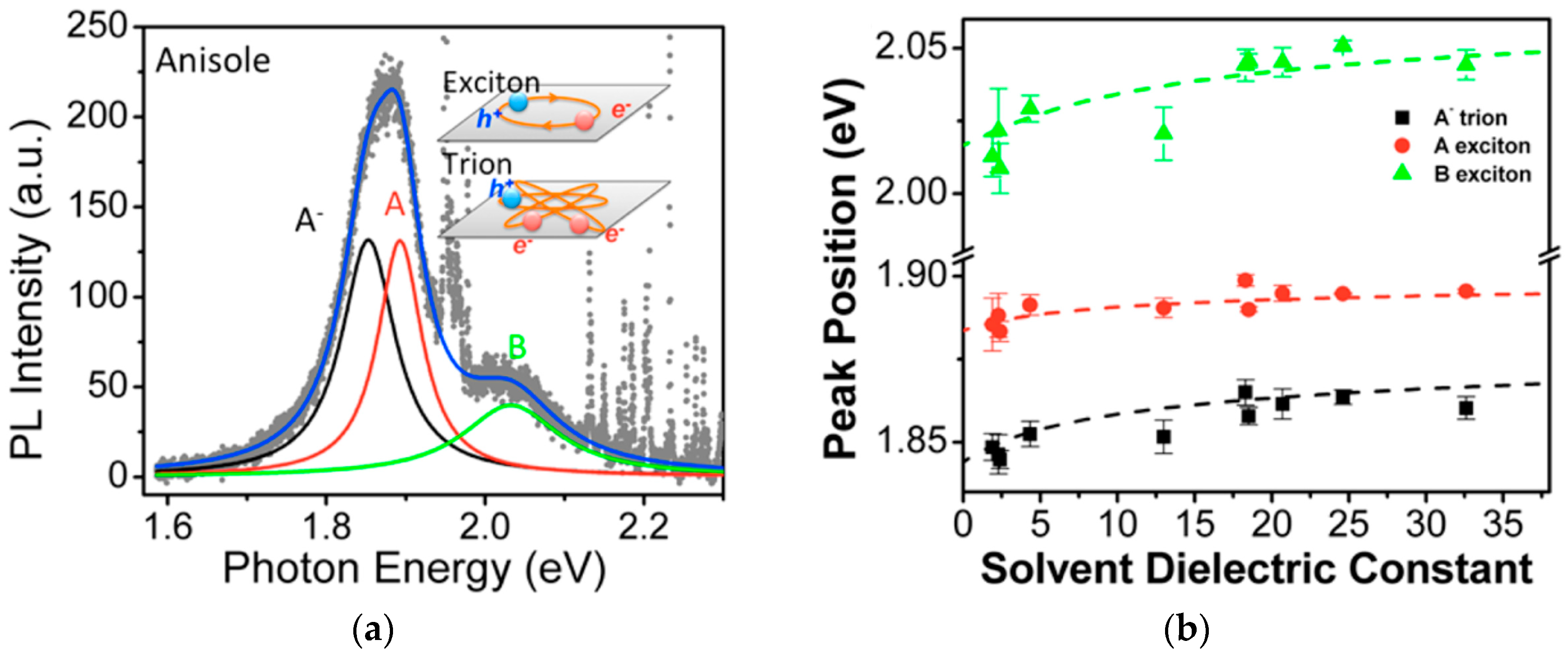
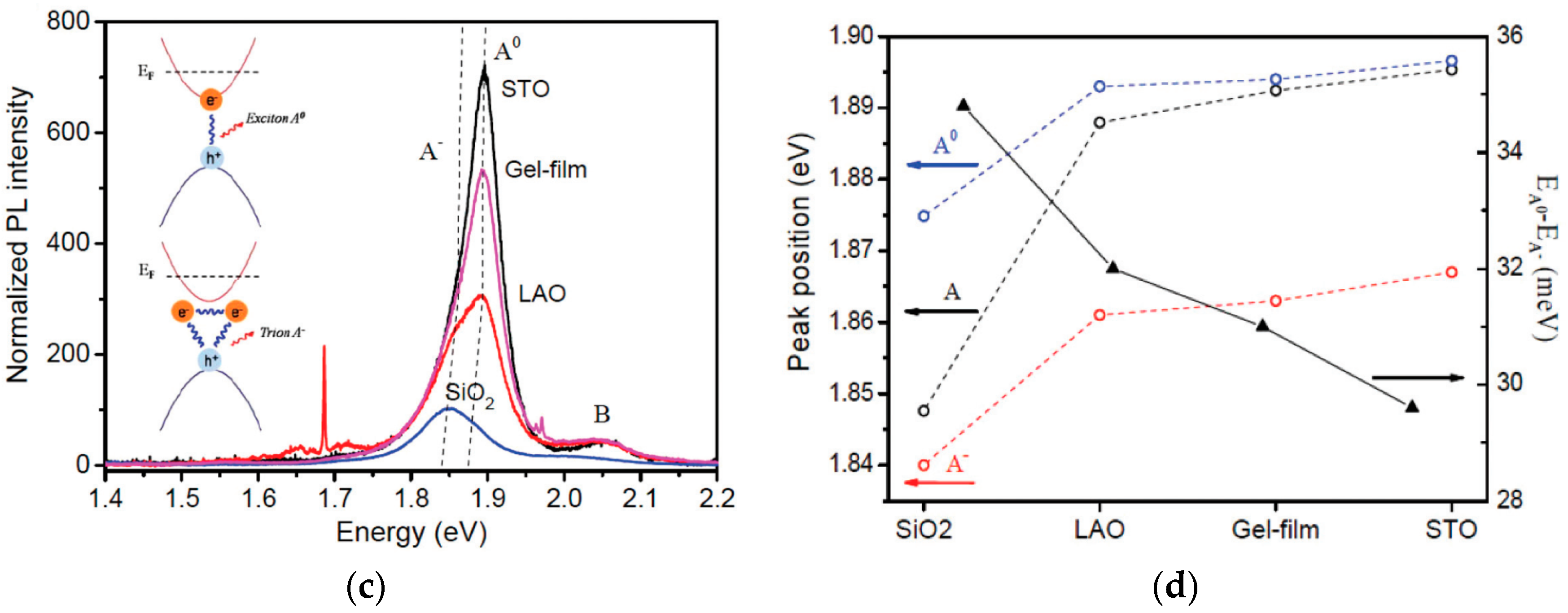
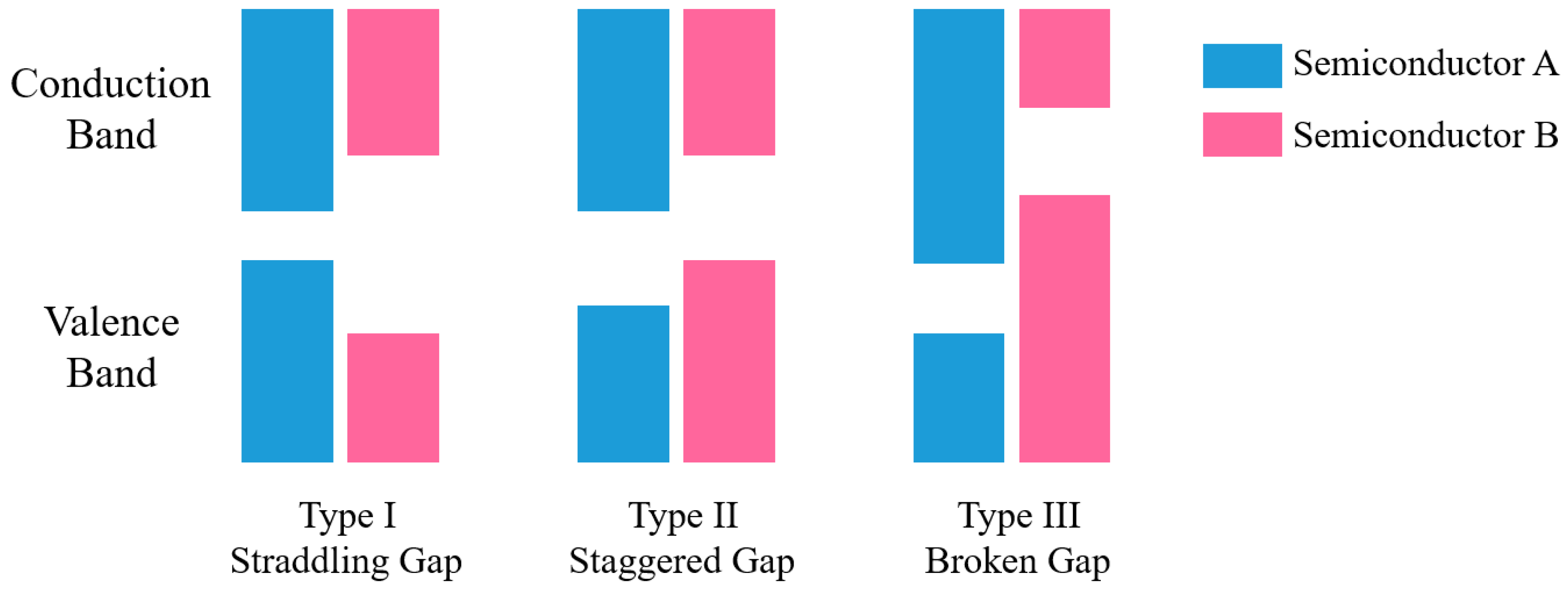
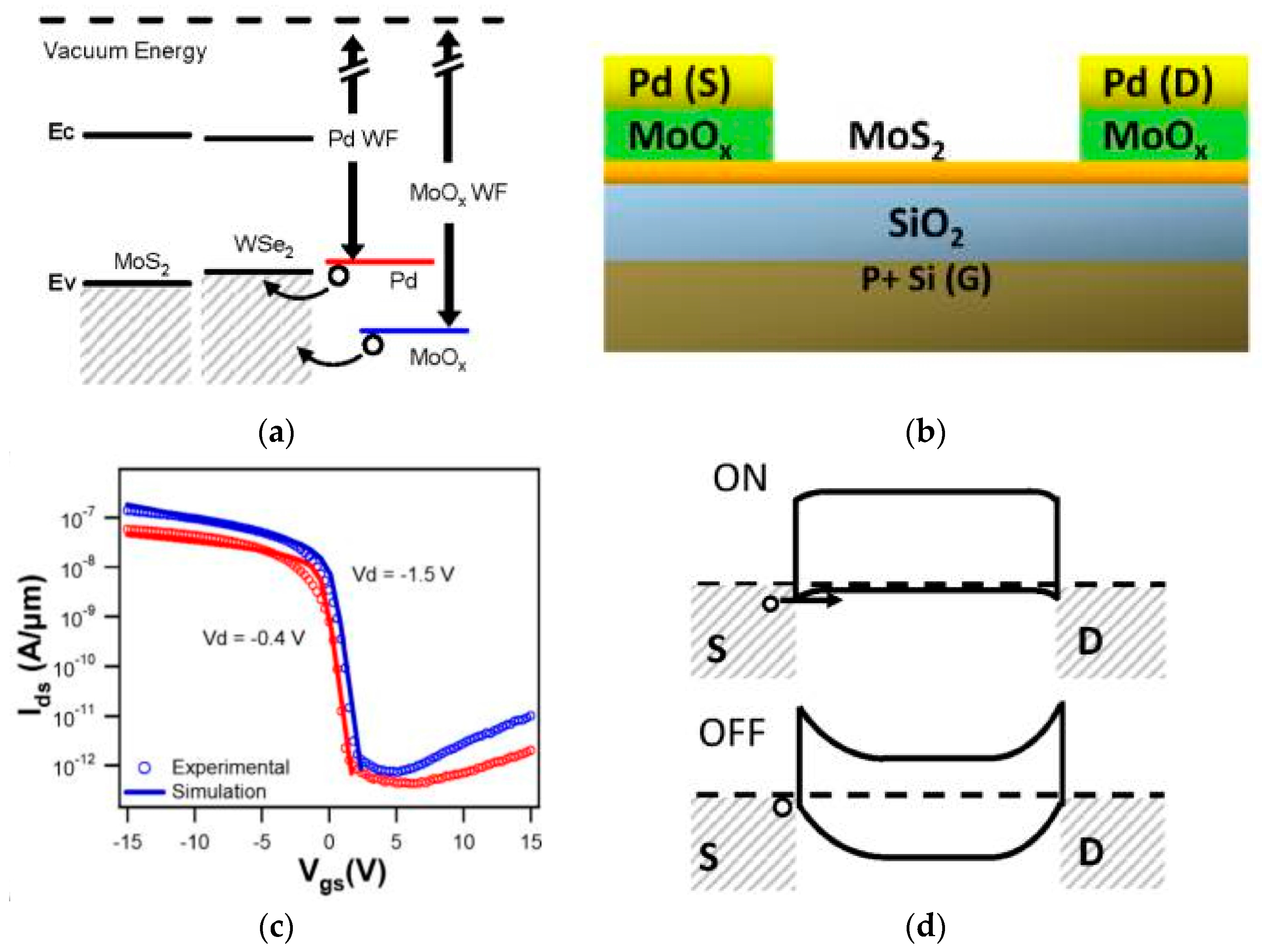
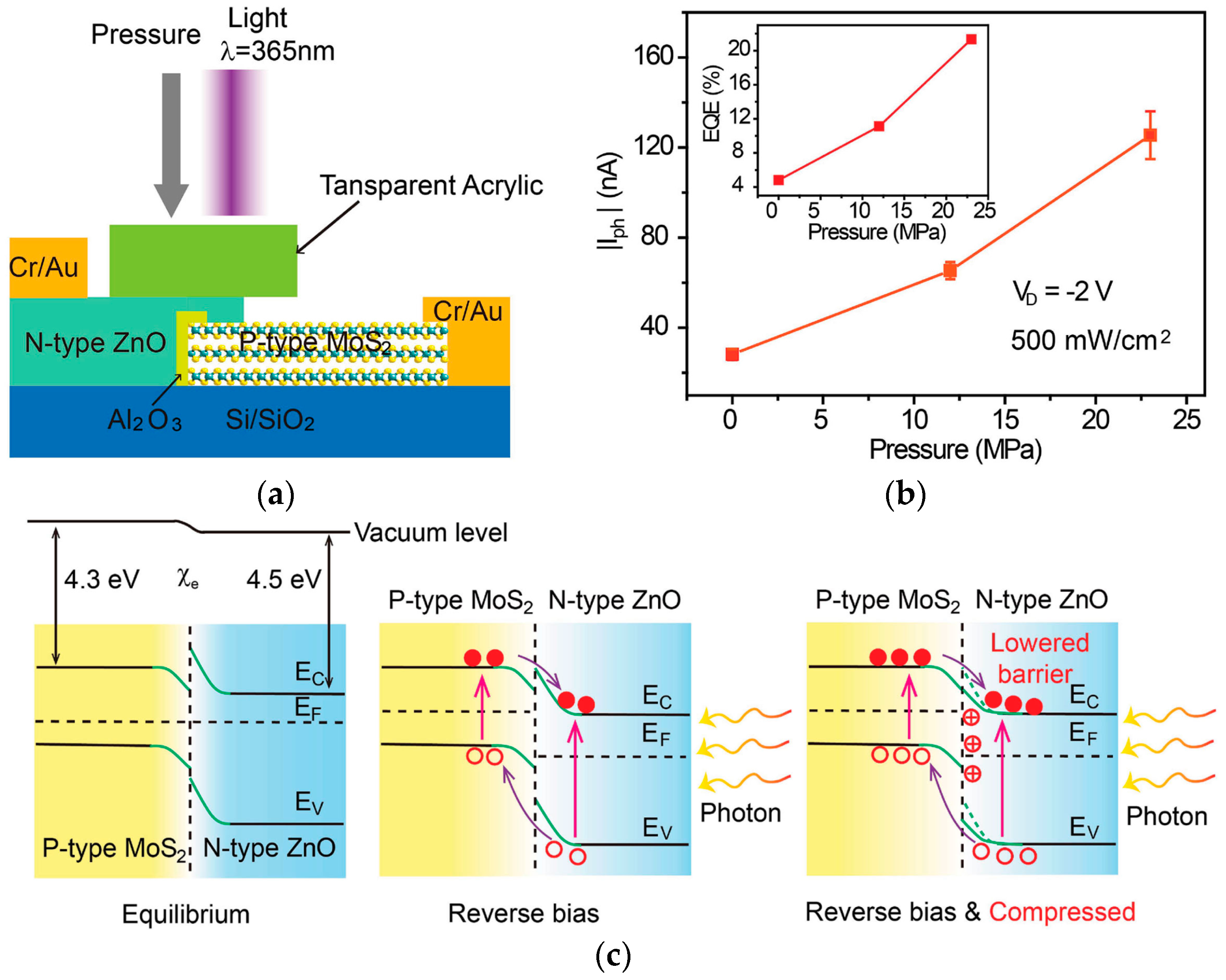
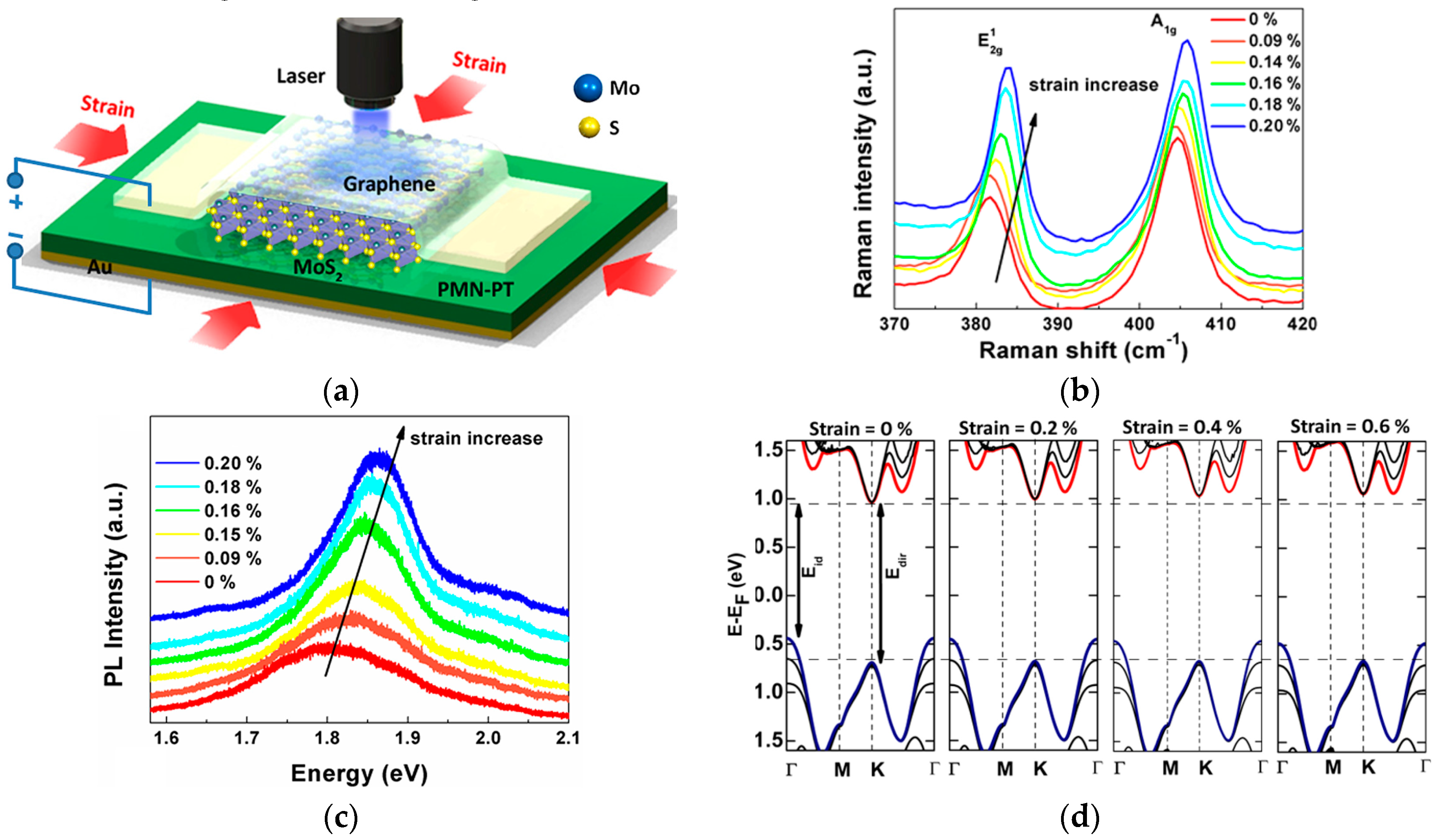
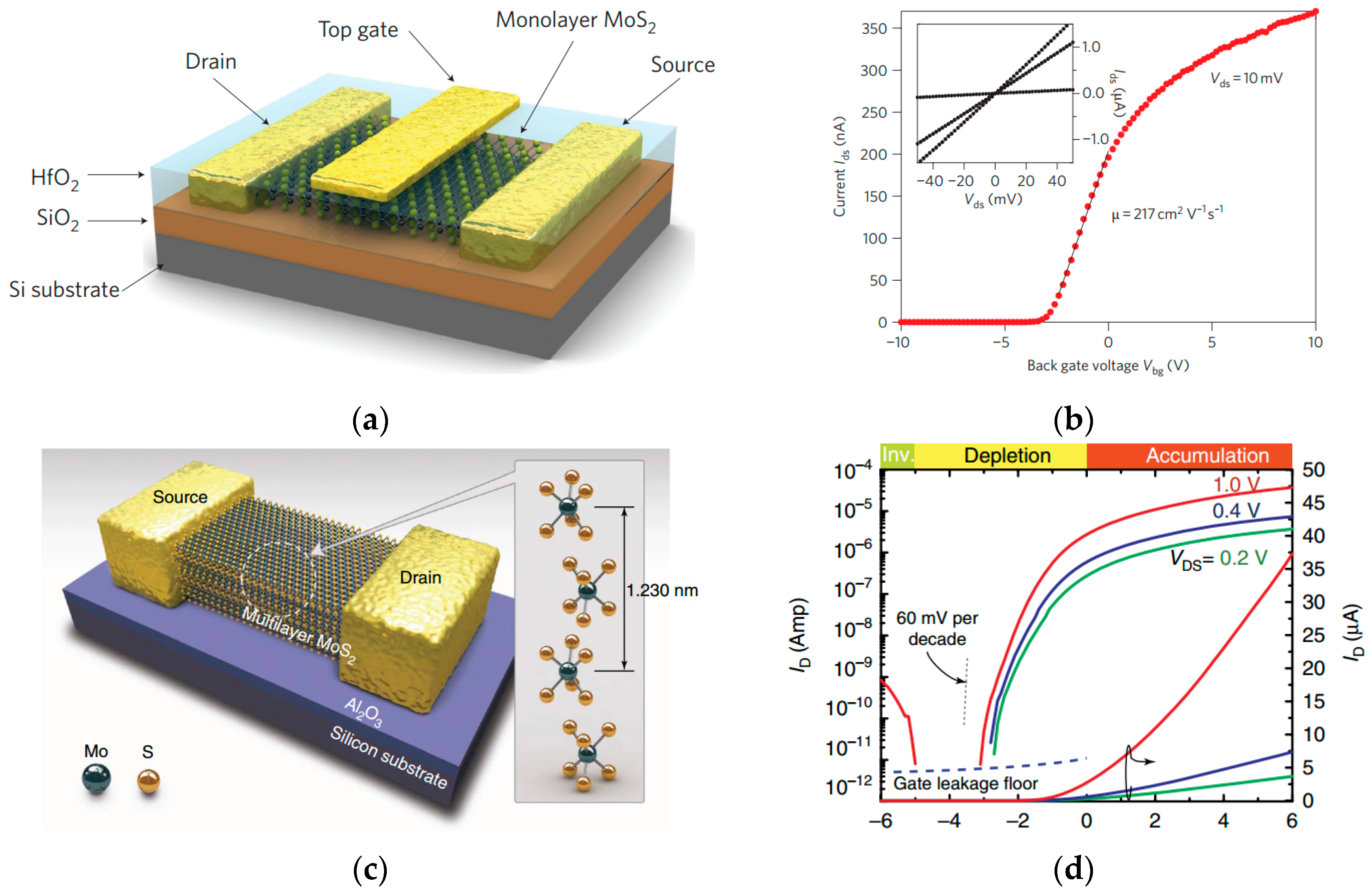
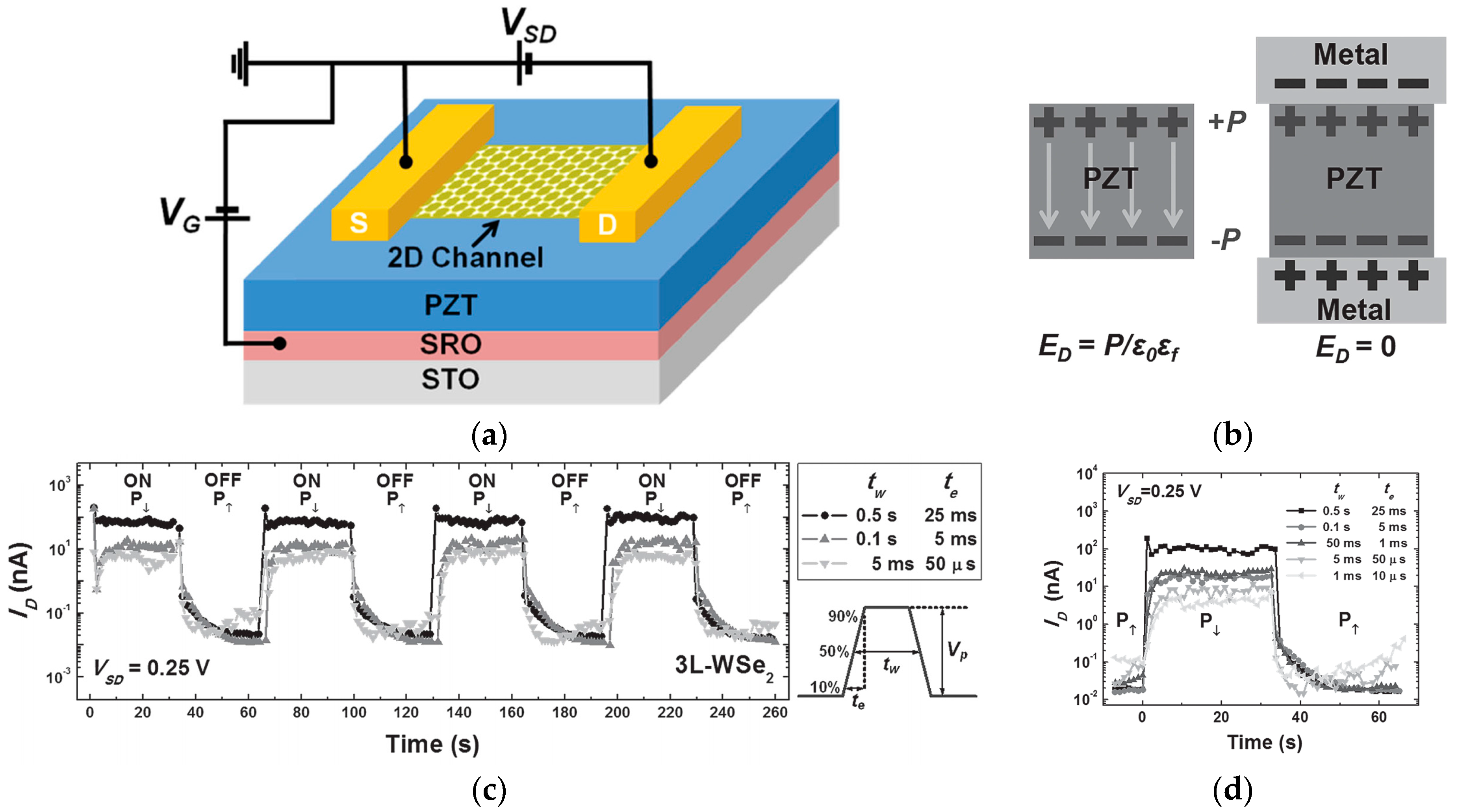
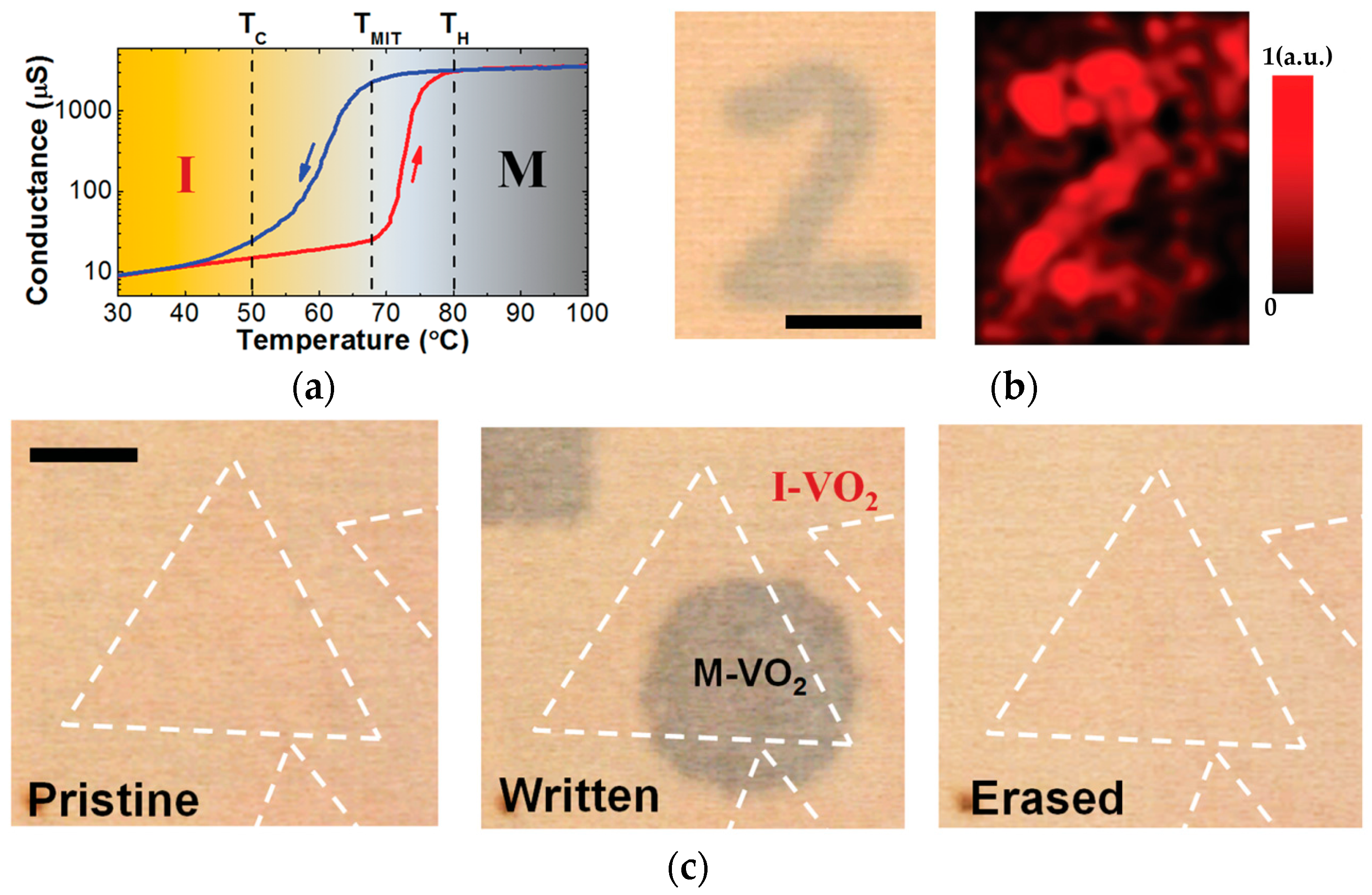
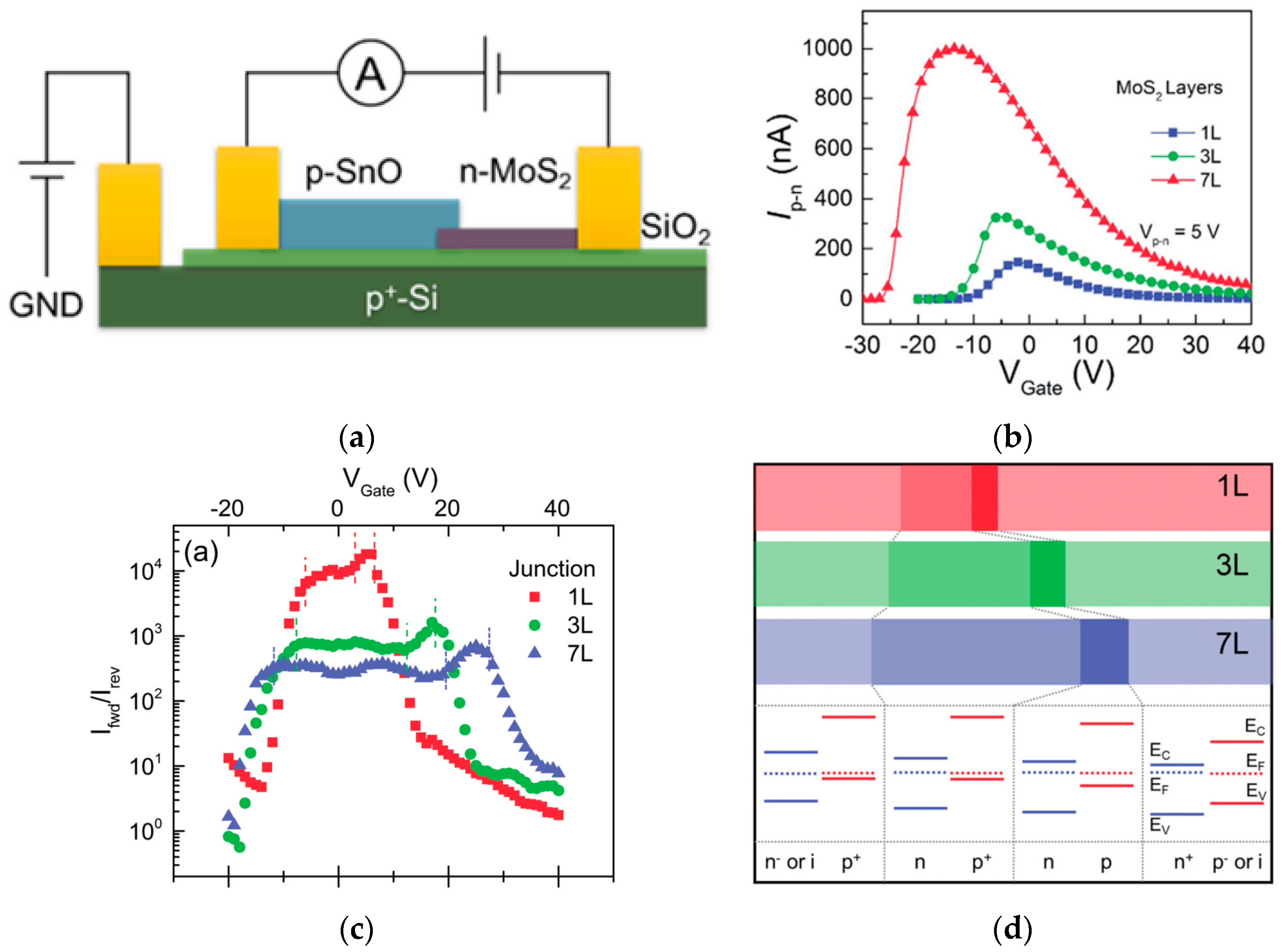
© 2017 by the authors. Licensee MDPI, Basel, Switzerland. This article is an open access article distributed under the terms and conditions of the Creative Commons Attribution (CC BY) license (http://creativecommons.org/licenses/by/4.0/).
Share and Cite
Yuan, Z.; Hou, J.; Liu, K. Interfacing 2D Semiconductors with Functional Oxides: Fundamentals, Properties, and Applications. Crystals 2017, 7, 265. https://doi.org/10.3390/cryst7090265
Yuan Z, Hou J, Liu K. Interfacing 2D Semiconductors with Functional Oxides: Fundamentals, Properties, and Applications. Crystals. 2017; 7(9):265. https://doi.org/10.3390/cryst7090265
Chicago/Turabian StyleYuan, Zhiquan, Jiwei Hou, and Kai Liu. 2017. "Interfacing 2D Semiconductors with Functional Oxides: Fundamentals, Properties, and Applications" Crystals 7, no. 9: 265. https://doi.org/10.3390/cryst7090265





